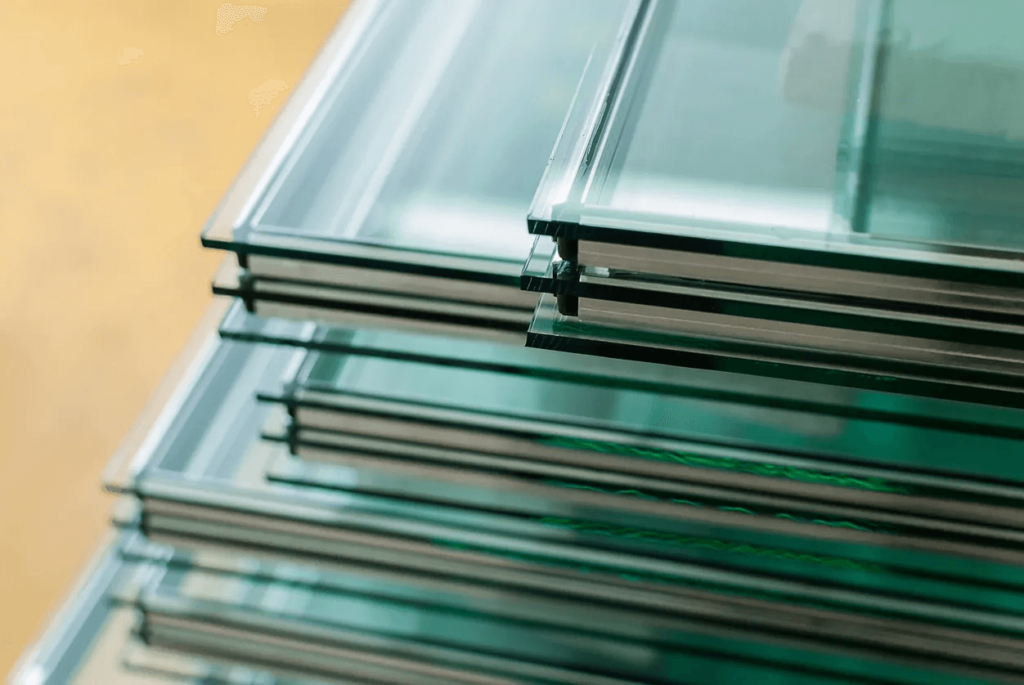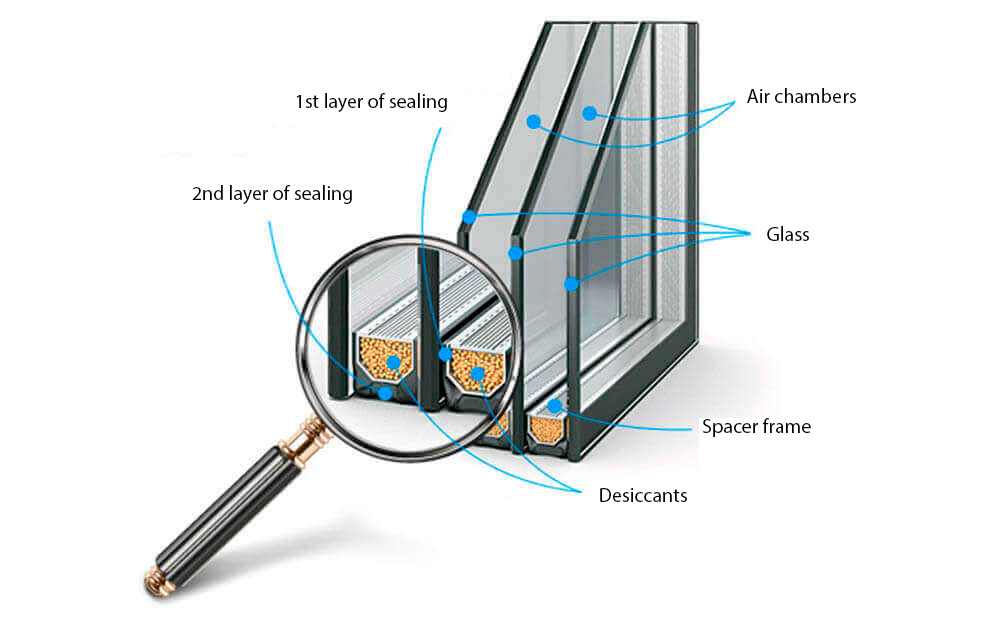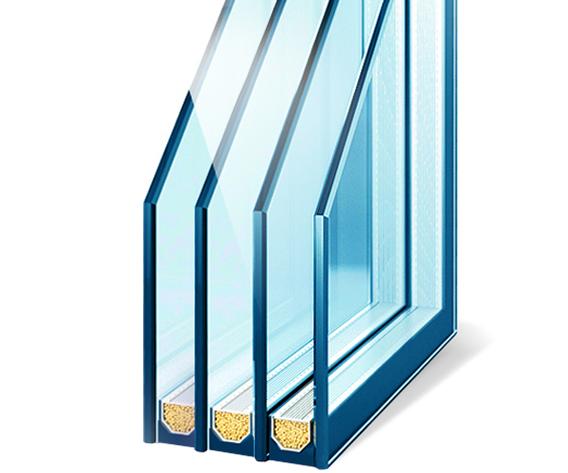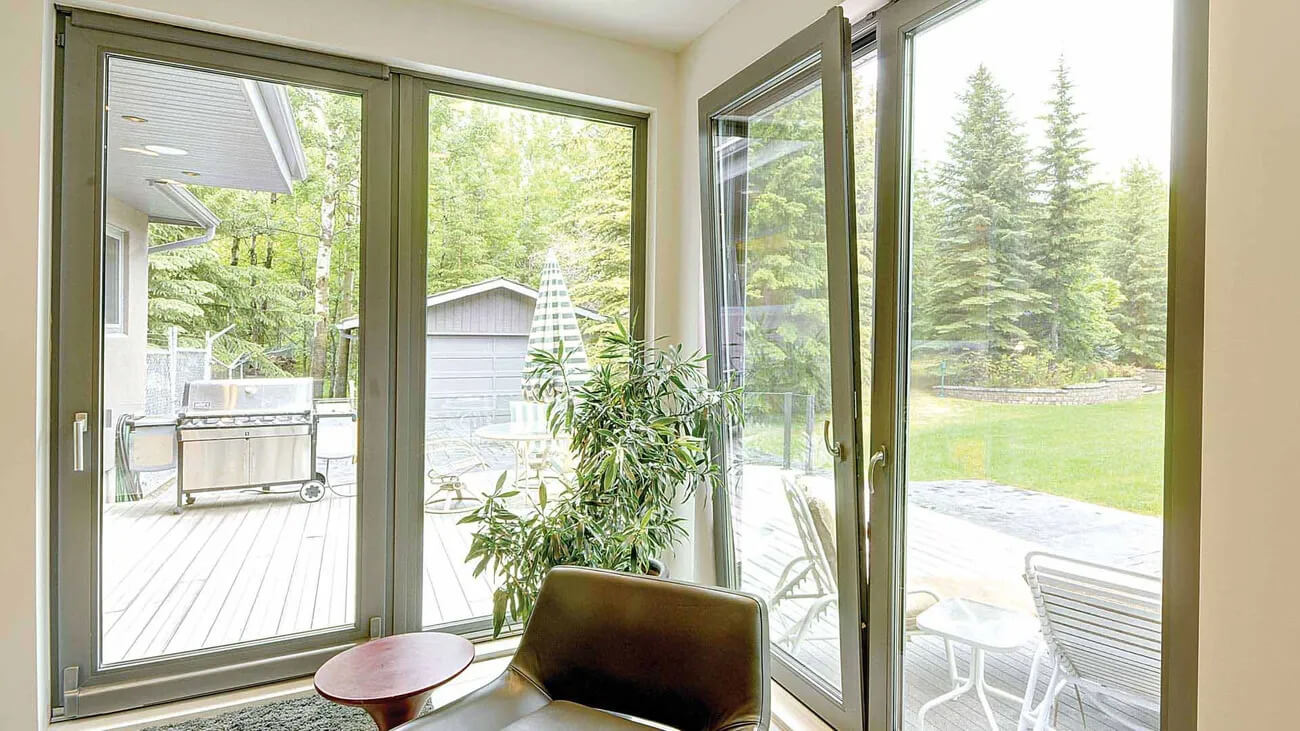The thermal insulation and soundproofing properties of metal-plastic windows depend directly on the quality of the glass unit inserted into the frame. Many buyers mistakenly believe that the operational characteristics of PVC windows are determined solely by the parameters of the frame profile, so they pay little attention to the glass unit. However, it occupies more than 80% of the total window area and affects not only the light-transmitting ability of the structure but also the level of heat preservation and sound insulation in the house.
Various glass units are available on the market, differing in glass thickness, type, number of glass panes, and thickness. To choose the right window, it is necessary to know the types of glass units for plastic windows, which parameters to pay attention to, and which are secondary, which qualities are genuinely useful, and which are nothing more than advertising “gimmicks.”
Varieties of glass units by the number of chambers

Structurally, a glass unit consists of two or three parallel glass panes installed at a certain distance from each other. The glass panes are bonded to a special structure – a spacer frame made of metal or plastic of a certain width.
It performs several functions:
- Joins the glass into one structure;
- Determines their parallelism;
- Seals the internal space (chamber);
- Reinforces the glass unit;
- Allows excess moisture to be removed from the chamber.
Single-chamber glass units consist of two glass panes and one spacer frame, while double-chamber units consist of three glass panes and two frames.
Only the highest grade M1 glass is used for glass units, known as float glass. It is produced using a very interesting technology, invented in the UK in the 1950s. It involves pouring molten glass (a mixture of sand, dolomite, calcined soda, and lime, with a melting point ≥ 1000°C) into a bath of a predetermined shape onto a layer of molten tin (melting point = 232°C). The molten tin possesses all the properties of a liquid, the main one in this case being the formation of a perfectly smooth horizontal surface. The high density of the metal prevents the formation of waves and bubbles from air movements.
Glass mass is poured onto the metallic mirror, spreading across the surface with a layer of specified thickness and cooling to the temperature of complete crystallization. The sheet of glass obtained has exceptional parameter accuracy, high transparency, and the absence of defects that often occur during uneven cooling.
Part of the float glass is used immediately after cooling, while part undergoes tempering – re-heating to a high temperature below the melting point and rapid cooling. As a result, the internal structure of the material changes, making it stronger and safer. When broken, it shatters into rectangular pieces incapable of cutting or injuring a person in any other way. Some glass units are based on tempered glass.
Single-chamber glass units

The most common type of glass unit. It is used in virtually all windows for technical purposes in offices, industrial premises, shops, restaurants, cafes, and warehouses. A significant portion of PVC windows in homes and apartments are also equipped with single-chamber glass units.
Main advantages:
- Lightweight;
- Adequate level of thermal insulation;
- High light transmission;
- Affordable price.
The thickness of the glass unit is within the range of 24-54 mm with a glass thickness (standard) of 4 mm. Some glass units can be made of thicker glass, but the overall width of the unit does not exceed the permissible range.
It is very convenient to use single-chamber glass units with energy-saving glass. One of the main advantages is retained – the lightness of the structure, while the thermal insulation properties increase significantly.
Double-chamber glass units

This design also belongs to the main types of glass units for plastic windows. Recently, the overwhelming majority of windows for the residential sector are produced with this type of glazing. The overall width of the unit does not exceed the dimensions of a single-chamber unit – 18-54 mm. Three glass panes, each 4 mm thick, occupy 12 mm of the width of the glass unit, with the rest being occupied by air chambers. Naturally, the widest glass units have the highest level of thermal insulation.
The sound insulation level of double-chamber glass units is significantly higher than that of single-chamber units, but it can be further increased by using spacer frames of different widths – in this case, sound waves are actively dampened due to asynchronous vibrations of the glass.
Triple-glazed windows

These are used less frequently than double-glazed and much less frequently than single-glazed windows.
There are several reasons for this:
- Greater weight of sashes, requiring the use of stronger, and therefore more expensive hardware;
- Minor increase in sound insulation properties;
- Reduction in light transmission;
- Decrease in the thickness of air chambers;
- Increase in cost.
Triple-glazed windows (4 glass panes, 3 spacer frames) are justified only when used in very cold climates with an increased frame width. In ordinary windows, besides accelerated wear of hinges and a decrease in the intensity of natural light, no other effect is observed. These same limitations apply to four-glazed windows, which can only be considered as special designs for specific operating conditions.
Variation of glass units depending on the gas used to fill the chamber
The main properties of the glass unit – thermal conductivity and sound insulation – largely depend on the gas injected into the chambers. Light transmission is practically unaffected by this – the main role here is played by the characteristics of the glass itself.
In budget-level glass units, dry air is injected, which has sufficiently low thermal conductivity, high transparency, and does not differ in chemical composition from atmospheric air. In more expensive glass units, argon, krypton, or xenon are used – inert gases, completely harmless to humans. There is no need to worry that in case of damage to the sealing layer, these gases will penetrate into the room. Even if this happens, they pose no danger.
In terms of price, such glass units differ slightly, depending not so much on consumer properties as on the cost of the gas. Argon is the cheapest, while xenon is the most expensive. The main qualities of inert gases are manifested when used in glass units equipped with energy-saving glass (i or K). But even with ordinary glass, some indicators improve, though not as sharply.
Useful qualities of inert gases:
– Reduced thermal conductivity coefficient;
– Reduced risk of condensation;
– Protection of internal coatings from oxidation.
But despite the clear advantages, glass units filled with inert gases are not without drawbacks. The main one is that the gas must be injected at a pressure higher than atmospheric. This requires increased strength of the sealing layer along the edge of the glass unit. The high permeability of the inert gas determines its leakage through the smallest sealing defects. Even in the best glass units, up to 3% of the gas evaporates within a year.
The average service life of a glass unit filled with inert gas in an energy-saving window is 10 years, after which the glass unit needs to be refilled with gas. This is associated with some inconvenience and additional expenses.
Furthermore, there is another risk factor – inert gases are odorless and colorless, making it extremely difficult to determine what exactly is injected into your window. If you are buying an expensive window from a reputable manufacturer, you can be sure that the chamber contains an inert gas. But in other cases, there is no 100% certainty.
Types of glass units by functional purpose
The main types of glass units for plastic windows are standard float glass and air as a filler. The practice of using glass units shows that this option is the most practical in terms of operational properties and price. A well-made single or double-glazed glass unit completely satisfies all the requirements imposed on plastic windows, and in conditions of moderate climates, nothing better can be desired.
But progress is relentless – PVC window manufacturers are constantly working on improving designs. Sometimes the differences between a standard glass unit and an enhanced one are understood only by specialists. Some innovations may seem completely unnecessary at first glance, but upon closer inspection, the benefits are quite real and significantly improve the functionality of metal-plastic structures (both windows and doors).
Multi-functional glass units
One of the most common enhancements concerns the glass, the main element of a glass unit. In multi-functional glass units, ordinary glass is coated with molecules of silver or chrome. Virtually invisible under normal lighting, it does not allow long-wave radiation (infrared spectrum), which prevents overheating of the room during hot weather when exposed to direct sunlight. Additionally, during cold weather, such glass units help retain heat as the applied coating reflects heat from heating devices back into the room.
Moreover, the entire visible spectrum passes through the glass without delays or restrictions — the light transmission of the glass unit is no different from regular glass. The coating is applied only to the glass that is inside, in the case of a single-glazed unit — on the inner surface. It is very durable and designed for long-term use; its durability practically does not differ from the service life of the entire window structure.
Such a glass unit design allows saving up to 30% more heat in the house than a regular glass unit, which is reflected in the reduction of heat carrier consumption. Such glass units are particularly advantageous in houses with autonomous heating systems. Additionally, multi-functional glass units have enhanced sound insulation. The slight mirror effect reduces the possibility of viewing the interior from the street, while retaining a significant portion of ultraviolet light protects indoor plants from overheating.
Self-cleaning glass units
A very practical and convenient invention. The glass on the outer side is coated with a special transparent substance with minimal adhesion to most household and technical contaminants. The coating also has the ability to decompose any substances adhering to the glass under the influence of ultraviolet light. The resulting products are easily washed away by rain or blown away by the wind. Dirty water on such glass does not leave streaks or spots.
If there is no rain for a long time, the glass can simply be sprayed with water from a garden hose or water supply system. Such glass units are very convenient in high-rise buildings, glass facades, shop windows; they can be practically installed in cottages or houses in fixed sashes of wide windows. Self-cleaning glass units have the same transparency as regular glass. In one set, self-cleaning glass can be combined with energy-saving or tempered glass, increasing the versatility of the glass unit.
Soundproof glass units
Comfort in the home depends on several parameters, one of the main ones being silence. For cottages or country houses, this may not be so relevant, but for apartments (shops, restaurants, offices) facing busy streets or highways, sound insulation is essential.
The construction of soundproof glass units is somewhat different from regular ones. Thicker glasses, up to 6 mm, are used here. The outer glass is usually laminated glass. Typically, triple-glazed units filled with argon or krypton are used for soundproof windows. These gases have lower sound conductivity than air due to their higher density, which results in more noticeable resistance to the propagation of sound waves.
Often, soundproof glass units are made with chambers of different widths — this reduces the risk of resonant vibrations and amplification of certain sound frequencies instead of their attenuation. Even a difference of a few millimeters can significantly increase the level of sound insulation. The quality of installation of composite elements is of utmost importance:
- Glasses;
- Spacer frames;
- Hardware;
- Seals.
The overall level of external noise reduction in such glass units can realistically reduce by 25 – 30 dB. Even next to a six-lane highway, the noise level in the room will not exceed 55 dB, equivalent to the level of quiet conversation or office noise. Similarly, windows facing a typical city street will reduce noise levels to barely audible 30 dB.
Soundproof glass units cost slightly more than regular ones, but the increase in expenses by 25 – 30% is entirely justified — comfort at home is more important than money. Moreover, only a few soundproof units will be needed — for busy and noisy streets, at most one or two windows are installed.
Mirror glass units
Mirror glass units are appropriate not only on the ground floor — often mirror glasses completely change the exterior of a building, turning an ordinary unremarkable building into an architectural masterpiece.
In addition to high protective properties (against ultraviolet rays and prying eyes), they also have an increased level of strength. The thinnest metallic film has high resistance to accidental mechanical impacts and is absolutely unafraid of abrasives — silver or golden metal is applied to the inner surfaces and does not interact with the external environment.
However, when installing a mirror glass unit, several factors should be considered:
- Suitability in the building’s design;
- Preservation of relative “opaqueness” only during the daytime;
- Higher cost.
When internal lighting is turned on in the house, everything happening in the room becomes clearly visible from the street, just like with regular glass. Savings on curtains and blinds can only be achieved in offices or stores.
Colored glass units
Glass units with colored glass are usually used as part of facade decoration. But having undeniable design possibilities, they do not lose their practicality. Colored glasses protect the house from excess ultraviolet light, prevent viewing of the interior from the street, while allowing enough daylight to pass through. Also, with the help of colored glasses, you can create original interior lighting, giving it a certain atmosphere.
In most cases, the color is given to the glass by laminating special films onto the glass. However, you can also find glasses colored throughout their volume, in the composition of which various compounds are introduced during manufacture, changing the color without losing their main qualities — strength, heat resistance, chemical inertness.
The first option for glass units is more common — relatively low cost allows manufacturing colored windows industrially in any size. Colored glass, colored throughout, is quite rare; such glass units can be ordered individually only from a few manufacturers.
In addition to their attractive appearance, colored glasses also have increased strength. The laminating film prevents the glass from cracking upon accidental impacts and is not inferior in strength to triplex or tempered glass. However, when ordering colored glass units, it is not advisable to overdo the color saturation — a light shade is sufficient, without significantly reducing transparency.
A special case of colored glass units are tinted (darkened) ones using special film pasting. Such windows are very appropriate in modern interiors and, besides their decorative function, have excellent operational properties. Especially on the southern, southeastern side of the building, or in hot climates. In the latter case, the priority is not the thermal insulation properties of the window, but its ability to protect the room from direct sunlight and high outside temperatures.
Glass units with smart glass
The fashionable word SMART in the modern world is applied to self-regulating systems that respond in a certain way to changes in external conditions. In relation to windows, these are complex glass units that change transparency and thermal conductivity depending on external conditions. A complex interlayer is installed between the glasses, powered by an external power source, which reacts to changes in lighting intensity and temperature.
The complexity of the system also determines the relatively high cost of such windows. They are most often used in “smart home” systems, characterized by the complexity and high cost of the main nodes and components. If in such a house the costs for a “smart” window amount to 2 – 3% of the total equipment cost, then in an ordinary apartment or cottage, they will exceed 20, or even 30 percent of construction expenses.
Energy-saving glass units with K-glass
The essence of these glass units is that a thin layer of metal oxides, primarily silver, is deposited on regular float glass. It reflects electromagnetic waves.
In practice, this results in an increase in the heat-reflecting ability directed towards the side with higher temperatures. This helps to prevent heat in the summer in rooms protected by such windows and minimize heat loss in the winter. The thickness of the coating, 0.4-0.6 microns, does not reduce the transparency of the window but significantly enhances its mechanical strength. K-glass units are characterized by the relative simplicity of the technology and do not significantly add to the cost of the entire structure. If there is a choice between K and I-glass, then the K variant should definitely be chosen. In addition to the lower cost, such glass units will not bring any surprises throughout their entire service life.
Glass units with I-glass
The technology for making glass for such units is much more complex than “K.” The deposition is carried out in a vacuum and involves a kind of “sandwich” deposition, alternating oxide and metallic layers (oxide-metal-oxide). At the same time, the thickness of the metal layer (most often silver) is no more than 10-15 nm (10-9m).
Even such a thin layer of metal reduces the thermal conductivity of the unit by 90%, without changing the light transmittance. But the coating is quite vulnerable to external influences, so it is applied exclusively to the inner surfaces of the glass. Compared to K-units, I-variants allow saving 20% more energy for heating over the entire service life. Moreover, they are also 20-40% lighter, which allows for the installation of single-chamber, I-units of any size in walls with not very high load-bearing capacity and in structures of large area — shop windows, facades, panoramas.
Glass units of increased strength
The main requirement for glass units installed in windows on lower floors or in industrial premises is strength. Of course, it is practically impossible to protect glass from burglary, but it is not difficult to protect the window from accidental impacts and wind loads. For these purposes, glass units use: laminated, tempered, or reinforced glass. They have sufficiently high strength, transparency, and an acceptable price.
1. Laminated glass is a multilayer construction of float glass and a polymer film bonded with transparent adhesive. In case of damage, the sheet does not shatter into shards; the glass pieces remain attached to the film and do not pose a danger to others.
2. Tempered glass is heated to a certain temperature (above the melting temperature) and rapidly cooled in air or technical oils. As a result, its strength significantly increases, and its physical properties change — the strength increases by 3-5 times, and the resistance to bending increases at least twice. When broken, small pieces of parallelepiped shape are formed, unable to injure a person.
3. Reinforcement is carried out by gluing a polymer mesh to the glass or installing it inside the glass during production. Sometimes a steel mesh structure is used instead of polymer. Such glass has a quite original appearance and slightly reduced transparency, but its strength is not inferior to metal.

